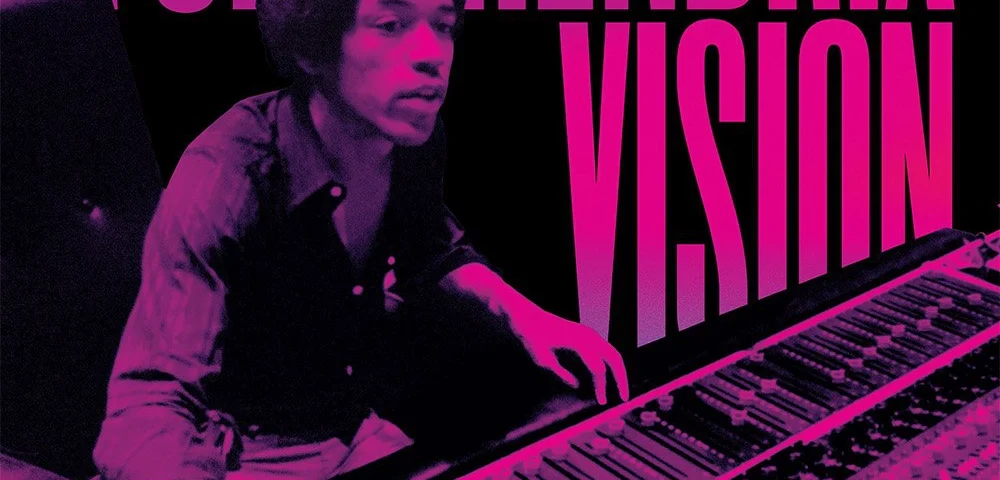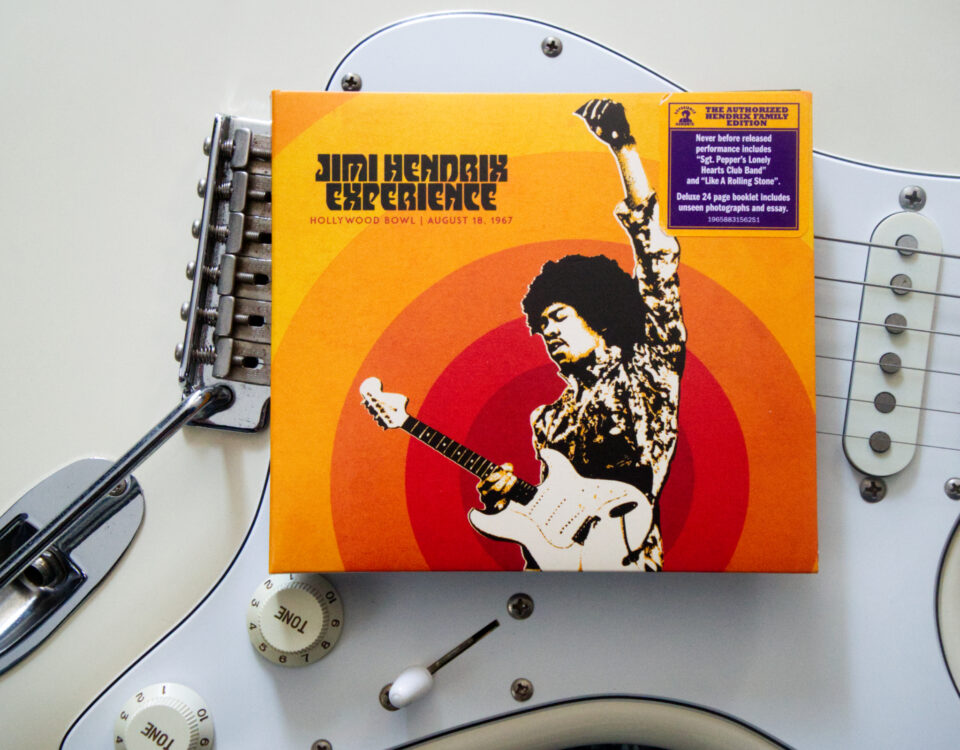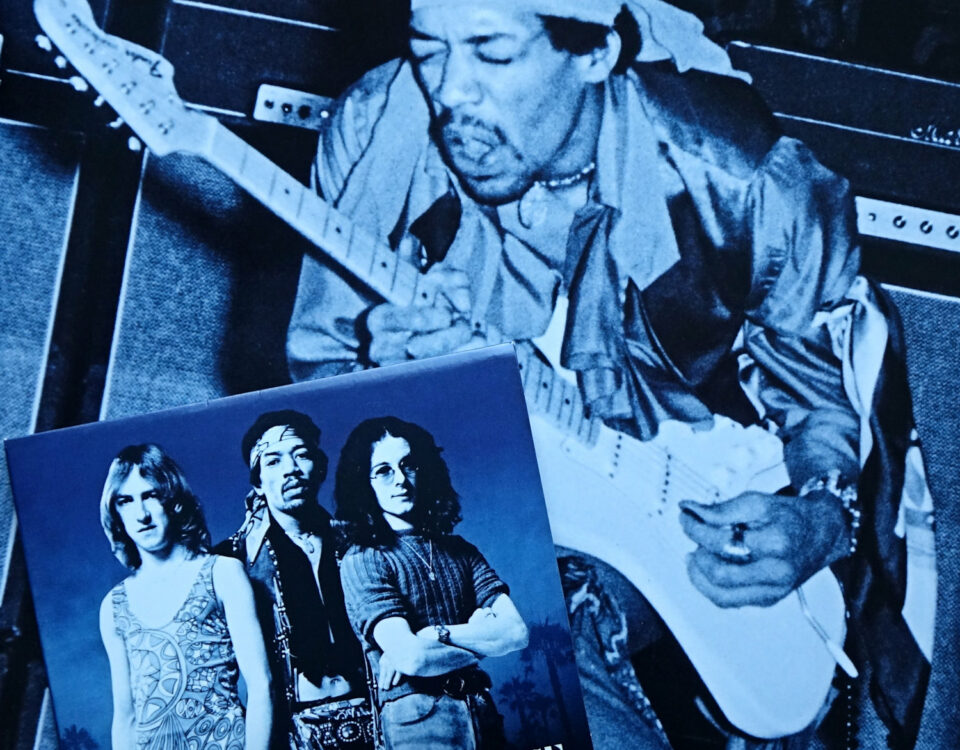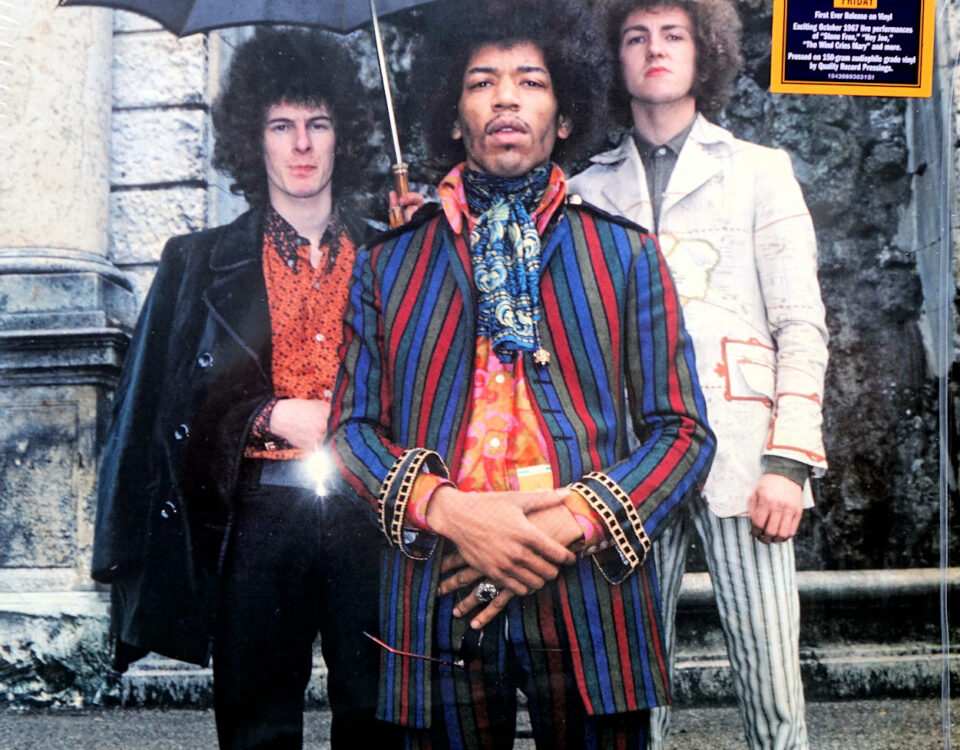CHAPTER TWENTY-EIGHT: THE LADY IS FASHIONABLY LATE

See that bag over there? Well, the cat got out of that bag so long ago there is not a trace of feline scent left behind.
That’s right, folks – an astounding two years and nine months after word of a massive box set titled Electric Lady Studios: A Jimi Hendrix Vision was first erroneously leaked to a ravenous public, here it finally is, arriving to claim your hard-earned dollars on Friday the 13th of September 2024. Oh, wait! One more delay – so, make that release date October 4.
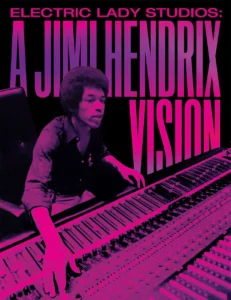
Promotional image for the cinema release of Electric Lady Studios: A Jimi Hendrix Vision, which had a commercial distribution in mid-2024, depicting Jimi at the Studio A recording console. (Experience Hendrix/Legacy)
Since word of this set’s existence first broke in January of 2022, squabbling was ongoing over the reason for the ever-increasing delay in Experience Hendrix and Sony Legacy assigning a release date, a situation exacerbated as slowly but surely a relative handful of copies of and components from the box set leaked into the hands of collectors.
But now it is officially here, in all its three-CD or five-LP glory. So, let’s crack that shrink wrap and assess what sprawls before us. Just a reminder: these free online chapters of Modern Listener Guide: Jimi Hendrix are much more informal than what you will encounter in the pages of the published book.
One other thing should be made clear from the start: despite the propensity of Experience Hendrix to market Jimi as a current day “rock star,” those seeking an introduction to his career or those who are intrigued by the hits from the first Experience album should get up to speed elsewhere in the Hendrix catalog. Why? Because this box set is heavy lifting.
Just as some breeds of dog are recommended for experienced canine handlers only, Electric Lady Studios: A Jimi Hendrix Vision requires an understanding of Jimi’s career and where he was in his life at the time this mass of material was recorded. The music reflects creative excitement and a career resurgence through new directions in music far from the constraints of Jimi’s early recordings. Yet it was also the byproduct of a largely uncertain and unsettled 1969.
Jimi had begun that year on the road with the original Experience trio, gigging on both sides of the Atlantic Ocean. But by mid-year that lineup had imploded, and Jimi found himself in a period of extended creative wandering – much of it documented via hours of tape consumed in expensive recording studios. Some of the steps he took in these efforts would eventually lead to brilliant successes, while others were pathways to sonic dead ends. Woodstock came and went that summer, as did the band that accompanied him on that legendary stage. Gypsy Sun and Rainbows would eventually be pared down to its core of Hendrix, Billy Cox, and Mitch Mitchell touring as the Experience 2.0, but not before Hendrix and Cox were teamed with Buddy Miles as Band of Gypsys, the trio that closed out 1969 and opened 1970.
A reset of the original Experience lineup was briefly floated early in 1970, but the idea was quickly flushed as Hendrix relied on Cox and Mitchell for both live work and recording. Those two career aspects were chained closely together. Jimi was hemorrhaging money in endless hours inhabiting studios, to the point where the logical solution seemed to be to build him his own studio. Logical, but the costs of bringing Electric Lady Studios into existence were mind-boggling.
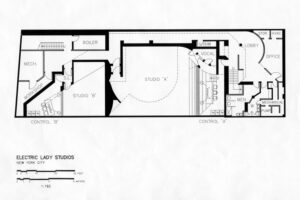
One of John Storyk’s design layouts for Electric Lady Studios, created after the original idea for a combination nightclub/studio had been abandoned. (Walters-Storyk Design Group)
The main logistical forces behind the studio’s creation at what had been a Greenwich Village nightclub called the Generation Club were engineer Eddie Kramer and designer John Storyk. Though both brought expertise and creative approaches to the construction that had begun early in 1969, endless delays and unanticipated problems were a constant – including the discovery of an underground river beneath the building site.
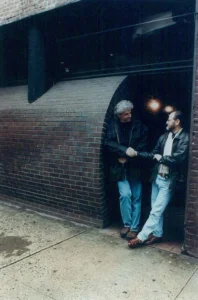
John Storyk (left) and Eddie Kramer return to the scene of the potential crime, for surely there were moments when they were ready to kill each other. Back at Electric Lady decades later, the men behind the creation of Jimi’s studio take pride in their imposing accomplishment, standing by the studio’s distinctive curved exterior wall. (Walters-Storyk Design Group)
To keep the project funded and with any hope of actually being completed, a massive advance from Jimi’s US record label, Warner Brothers, was hastily arranged by manager Mike Jeffery. But even with that financial transfusion the flow of cash out demanded yet more coming in, so Hendrix had to capitalize on his fame with a series of gigs in 1970 – though a compromise with Jefferey led to most shows being on weekends so Jimi could record on the other days. The occasionally incendiary performances Jimi conjured up that year took place largely in huge sports arenas and at massive rock festivals in Georgia, New York, and the United Kingdom.
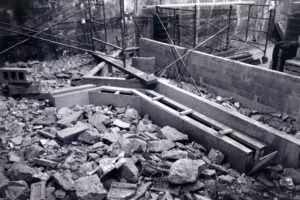
Not quite looking like a cutting-edge recording studio just yet. The light at the end of the Electric Lady Studios construction tunnel was not yet in sight. (Walters-Storyk Design Group)
At last, though, the miraculous completion of Electric Lady Studios seemed within reach. Early in June Kramer was conducting technical tests, and by the middle of the month, at last, Jimi recorded his first music in what was envisioned as his long-term creative home.
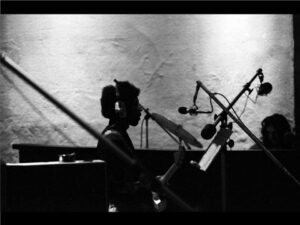
Box set content creator, circa 1970 – Jimi Hendrix at work in his new Electric Lady Studios, “ear goggles” in place. (Walters-Storyk Design Group)
So, it is at this very point Electric Lady Studios: A Jimi Hendrix Vision opens a sonic window on the efforts of Jimi Hendrix to settle on the contents and finish the recording of his fourth official studio album, sometimes with foundational tracks recorded earlier at other studios being polished at Electric Lady.
For such a massive box set, it is rather amazing that its focus is a tight time frame lasting just a few weeks. Jimi Hendrix first entered the working Electric Lady Studios in mid-June, then flew to Europe – never to return – on August 26. But the amount of work he accomplished belies that mere handful of days.
As mentioned earlier, the two variations of Electric Lady Studios: A Jimi Hendrix Vision sprawl across three CDs or five LPs, and both editions are accompanied by an identical Blu-ray disc.
Usually, supplemental materials like the Blu-ray get mentioned toward the end of our chapters. But in this case, I mention it first. The reason? You may well wish to take in the documentary program (conveniently also titled Electric Lady Studios: A Jimi Hendrix Vision) to set the stage for the hours of music you will later be absorbing through speakers or “ear goggles” (Jimi’s amusing description of headphones).
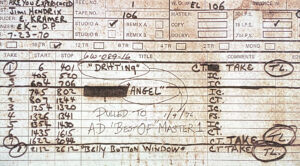
It’s interesting to note in this image that both “Angel” and “Drifting” were “pulled to A.D. ‘Best of’ Master 1” on January 9, 1976. This clearly refers to Alan Douglas, who was overseeing the Hendrix estate by that time, though what the “Best of” refers to remains unknown. (Screen grab from Blu-ray Electric Lady Studios: A Jimi Hendrix Vision, Experience Hendrix/Legacy)
Certain documentaries accompanying box sets dedicated to the career of Hendrix almost have a paint-by-the-numbers feel to them. They corral the same usual suspects saying the same things they have uttered many times before in front of the cameras. I am happy to say Electric Lady Studios: A Jimi Hendrix Vision breaks that mold.
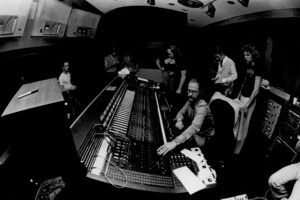
Eddie Kramer overseeing the Studio A console – the heart of the recording equipment at Electric Lady Studios. (Walters-Storyk Design Group)
The troubled path that eventually led to the realization of Electric Lady Studios in Greenwich Village is effectively told by many of the people who did the actual work to make it happen. This ranges from designer/architect John Storyk – cutting his acoustician teeth under the most difficult of circumstances – to studio president Jim Marron, who continually scrambled to keep the project’s halting momentum alive. Linda Sharlin, the studio manager who essentially coordinated studio operations and logistics once the facility was open, sheds interesting light on the occasionally chaotic day-to-day activities. And of course, Eddie Kramer weighs in not only on recording Jimi Hendrix, but on the technical attractions of Electric Lady that soon drew in artists like Led Zeppelin and Stevie Wonder.
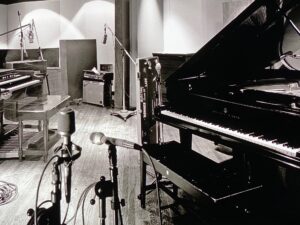
Several references are made in the Electric Lady Studios: A Jimi Hendrix Vision documentary about the magnificent Yamaha piano in place when the studios opened, an instrument used by Eddie Kramer in the very first recording checks. Yet the image shown in the Blu-ray clearly depicts a Steinway & Sons instrument. (Screen grab from Blu-ray Electric Lady Studios: A Jimi Hendrix Vision, Experience Hendrix/Legacy)
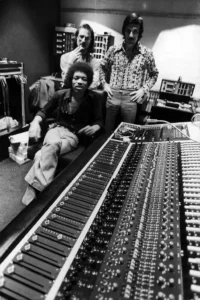
Jimi Hendrix in the control room, backed by engineer Eddie Kramer (left) and Electric Lady Studios president Jim Marron. (Walters-Storyk Design Group)
Also on the Blu-ray – and an excellent sonic warm-up for the rest of the box set contents – are new 5.1 mixes of the complete First Rays of the New Rising Sun album that was originally released way back in April, 1997, on MCA Records. At that time the dust was still settling from the end of the Alan Douglas era as control of the Jimi Hendrix estate had just passed to the then-new entity Experience Hendrix. First Rays was Experience Hendrix’s interpretation of what Jimi’s fourth studio album might have been, and – arguments about the tracks selected and their order aside – the selections sound impressive in this modern-mix guise. The track lineup is supplemented with three additional surround mixes of “Valleys of Neptune,” “Pali Gap,” and “Lover Man.”
Like almost all other Experience Hendrix releases, the interior and exterior packaging of Electric Lady Studios: A Jimi Hendrix Vision bears the visual cues and layouts customary of Phil Yarnall/SMAY Design. Whether you like this signature approach or are sick of it is a matter of personal taste.
Interestingly, while Experience Hendrix has generally favored packaging their CD box sets in vertical, rectangular-shaped “book” formats, the CD version of Electric Lady Studios: A Jimi Hendrix Vision comes in a square eight-inch by eight-inch box, with the booklet and CD/Blu-Ray storage wallet being separate components.
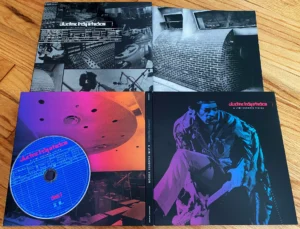
The compact disc configuration of Electric Lady Studios: A Jimi Hendrix Vision, showing the exterior box in the upper left with booklet to the right, above the half-unfolded disc storage wallet. (Modern Listener Archives)
Both CD and vinyl box exteriors boast a nice textured panel headlined by the “Electric Lady Studios” logo, accompanied by black and white images reproduced on reflective silver. To my mind, it is very effective and attractive packaging.
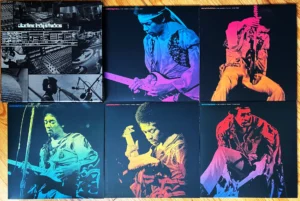
The vinyl album configuration of Electric Lady Studios: A Jimi Hendrix Vision, showing the exterior box in the upper left and the five separate, colorful sleeves, each containing one of the five LPs. Not shown is the full-size booklet that accompanies the albums. (Modern Listener Archives)
Layout differences between each format’s 48-page booklet are very minor, aside from the page content reflecting the running order of either CD or vinyl. This may have influenced the decision to make the CD package square, for ease of dealing with text variations between the two. Of course, the vinyl book is considerably more impressive given each page’s substantially larger real estate for photo reproduction. That also carries over to the artwork sleeves of the five LPs; though the same images appear on the CD set’s disc storage packaging, they certainly pack more of a punch when seen 12.5-inches square.
But of course, why are we really hefting these big boxes around? It is for the music, so let’s dig in.
For the sake of convenience, we will muddle through Electric Lady Studios: A Jimi Hendrix Vision utilizing the running order of the three-CD edition of the release, which will surely be the biggest seller. However, it is worth noting that the vinyl edition does provide an alternate listening experience with the tracks appearing in a significantly different running order.
The first CD opens with “Ezy Ryder,” one of many tracks that had been started elsewhere – in this case, New York’s Record Plant – but were then brought into the Electric Lady environs to be completed. Eventually released on The Cry of Love, the music heard here is largely familiar, with this track documenting guitar overdubs that would have a slightly less prominent level in the iteration eventually released.
However, jaded ears will certainly perk up with “Valleys of Neptune,” recorded on Jimi’s first serious night of from-scratch recording in his new studio, June 15, 1970. Joined only by Steve Winwood on electric piano and a primitive rhythm machine, Hendrix plays several lovely melodic passages on this instrumental passage through the song’s progressions. He lays back occasionally, offering Winwood the freedom to create his own gentle cascades.
An extended dialog of “studio talk” yields to backing track passes through “Straight Ahead,” with Jimi’s Stratocaster pickups set to a clucking middle position. Accompanied by Mitch Mitchell on drums and Billy Cox on bass and recorded two nights after the Winwood session, Jimi takes charge calling out changes to Mitchell and Cox.
Hendrix’s obsession with Bob Dylan surfaces with two unsuccessful attempts at “Drifter’s Escape,” though the real interest is in fly-on-the-wall moments of equipment and studio gear realities being discussed or joked about, the banter largely between Hendrix and engineer Eddie Kramer.
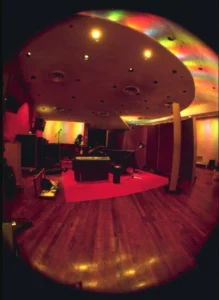
Jimi Hendrix often expressed music in terms of colors, and with the lighting control system at his new Electric Lady Studios he could match his creative vision with the sounds he was exploring. (Walters-Storyk Design Group)
It had become obvious that “Astro Man” was one of Jimi’s most promising new songs, and much attention was directed its way at Electric Lady. The next track on this first disc details loose work on specific aspects of “Astro Man,” most notable for Jimi having seriously detuned his low E string. The result is a gnarly, flopping tone that is engagingly snarling.
From there we move on to a breakneck-paced instrumental run through the full “Astro Man” composition, with all aspects of Jimi’s imposing guitar talents on vibrant display. From churning rhythmic propulsion to elastic bent-note vibrato, Hendrix’s approaches morph seemingly effortlessly. The take eventually dissolves, though Cox hopefully offers an enduring foundation should Jimi seriously decide to regroup. Jimi cannot resist a bit of chordal and single-note sparring, but it does feel a bit aimless at this point, and take is simply faded out after the eight-minute mark.
The mood shifts dramatically as focus turns to one of Jimi’s most beautiful and moving compositions, “Drifting.” One complete take impresses Hendrix enough to request it be kept as a potential candidate for further work, with a brief moment following as he turns to dialing in the song’s opening structure.
Since its release in March, 1971, a true highlight of The Cry of Love album is the outro of “Night Bird Flying, which rides to its conclusion on a churning nest of interlocking guitar parts. The song’s appearance here on Electric Lady Studios: A Jimi Hendrix Vision is relatively naked as heard in an earlier take, likely either an attempt at a backing track or merely reinforcement of the song’s structure for the benefit of Mitchell and Cox.
Recorded the same night as the earlier work on “Astro Man” – June 24, 1970 – a cover of Bobby “Blue” Bland’s 1957 hit “Farther on Up the Road” provides a momentary studio diversion from the more serious recording efforts. After the brief but energetic workout, Jimi closes the book on the song, wryly saying, “Anyway…” with a laugh.
“Brief” certainly does not describe the final music on this first disc. Recorded later that same night, what is identified in the liner notes as “The Long Medley” is an evolving, stream-of-Hendrix-consciousness journey through multiple songs and myriad ideas that runs for more than 26 minutes. Jimi restlessly travels from one song foundation to another, occasionally pausing to explore solo ideas or rhythmic approaches before changing direction with the next progression. A great example is a descending pattern which Hendrix effortlessly utilizes to pry the music from one languid pace into a totally different frantic convulsion. “Beginnings,” “Hey Baby (Land of the New Rising Sun),” “Keep on Movin’,” “Straight Ahead,” “Midnight Lightning,” “Freedom” – all receive impromptu musical visitations from Hendrix in what is surely a highlight of Electric Lady Studios: A Jimi Hendrix Vision. Such very long jams make one fact crystal clear: the musical endurance of Jimi Hendrix was astonishing.
Electric Lady Studios original logo, unquestionably created in a bold, period-correct font. (Modern Listener Archives)
The second CD kicks off with “Earth Blues,” an opportunity for Billy Cox to shine. The bassist was always reliable yet always creative, seemingly having a sixth sense about how to set up Hendrix’s compositional changes for maximum impact. If you can direct your ears to the bottom throughout these four minutes, you will be rewarded. This specific recording is another that had first come to life at the Record Plant, but was receiving considerable retooling at Electric Lady – including Mitch Mitchell laying new drums tracks in place of the original percussion by Buddy Miles.
“Dolly Dagger” unveils Jimi trying out some alternate vocal approaches while recording these versions of the track. With the musical structure set, Hendrix is clearly focused on the finishing touches. Indeed, the next take after these two passes yielded the final foundation for the song as released on Rainbow Bridge.
The differences between the final version of “Angel” and its appearance here are even more minimal. “How about that one?” Hendrix asks hopefully upon reaching the song’s conclusion, indicative of his belief that the creative target had been hit. He was right. Though a handful of overdubs were added following Jimi’s death before “Angel” was revealed to the world on The Cry of Love, this take is the foundation of that version, with the vast majority of the song’s delicate feel solidly in place.
The great percussionist Juma Sultan is heard on the next track augmenting Cox and Mitchell on “Beginnings.” This instrumental song had first been heard in public at Woodstock, when it was played by Jimi and those same three musicians, along with Larry Lee on guitar and Jerry Velez on congas. Here in Electric Lady the roiling treatment generated by the quartet is more controlled, demonstrating the sophistication of Jimi’s musical construction.
More than four dozen versions of “Lover Man” are known to exist, recorded live or in the studio. Here at Electric Lady on July 20, 1970, Jimi tried once again to capture the definitive version of a song he had tackled so many times. No matter the approach he took over all those versions, it seemed he could never quite realize his vision for the song, although this version – with its frantic solo mid-take that melds Jimi taking on “Flight of the Bumblebee” over the Batman theme chord progression – certainly stands as one of the very best, with its “perfect ending” as judged by Hendrix himself.
“Tune X/Just Came In” was soon to be christened “In from the Storm,” though here the highly effective, lumbering riff at its core is awaiting final refinement. It is no surprise Hendrix would return to it, with the raw material polished and eventually yielding one of Jimi’s strongest late-period songs.
The evocative “Heaven Has No Sorrow” was recorded on a four-track recorder at Electric Lady, a machine assigned to allow Jimi to demo new material with more sophistication without tying up a 16-track machine. Never fully developed, this song has great promise as can be heard in this aural sketch by Hendrix and Cox. Jimi’s fluttering accents reflect his plaintive words with equally emotional music.
Altering this disc’s mood entirely, the first of three versions of “Freedom” appearing throughout this box is a fully instrumental – and fully funky – take from late-June sessions. In fact, this June 25, 1970, take almost became the foundation for the final song as heard on The Cry of Love, but Hendrix felt he could improve it slightly. The very next full take became “the one.”
The next day Hendrix was focused on creating a four-track demo of “Valleys of Neptune,” again recording with just Billy Cox on bass. The song has a fascinating structure, and the fact that it was never fully completed to realize Jimi’s creative vision for it leaves the song an unfulfilled promise.
“Come Down Hard on Me” is a from a mid-July session and is another vibrant exploration through the realm of funk, with ample unison progressions and tight starts and stops by Hendrix, Cox, and Mitchell throughout.
“Dolly Dagger” next makes a second appearance in this box set’s running order, here described as an “alternate version” with a live overdub vocal. Juma Sultan again contributes percussion. In truth, it is so similar to the final version that there are no real surprises on hand beyond subtleties like overall guitar mix levels.
At just over 90 seconds, “Messing Around” is short on substance, based largely on a jaunty up-tempo progression. Though Hendrix dedicated a number of takes like this one in mid-June to the under-construction piece, it was never fully completed.
Two takes after the version presented earlier in this set, “Tune X/Just Came In” finds Jimi with lyrics in hand. Hendrix delivers an agitated vocal performance that calls to mind some of Buddy Guy’s more unhinged verbal moments. It is set off throughout with some of the finest guitar soloing in this box set, Jimi attacking the strings with angry bends and violent vibrato shakes. Then, as the pace begins to slow, Jimi seems to be improvising off-the-top-of-his-head lyrics, borrowing images from B.B. King’s “Don’t Answer the Door” while touching on ideas shared with another emerging song worked on at Electric Lady, “Midnight Lightning.”
An alternate version of “Drifting” acts as a soothing balm after the preceding song’s frantic energy, Jimi’s gentle playing treated through a Leslie rotating speaker effect. Of course, the song as heard here has yet to benefit from Buzzy Linhart’s evocative and atmospheric overdubs of vibes, added late in 1970 after Hendrix had died as Kramer prepared The Cry of Love for release.
“Freedom” next appears for a second time in the track listing, Jimi now armed with lyrics so he can toy with vocal phrasing. He has not quite reached final territory on that count, but at least the structure and most effective approach have revealed themselves.
This second disc closes with a lightly swinging “Belly Button Window,” presented here as a bluesy, lightly stepping interplay shared among Hendrix, Cox, and Mitchell, leading to a playful conclusion. With Mitchell displaying his jazzy skills with brushes, this track definitely resides in the same neighborhood inhabited by “Up from the Skies” on Axis: Bold as Love.
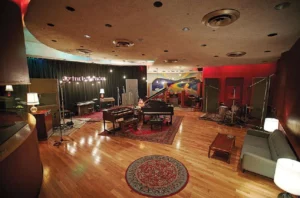
Electric Lady’s Studio A, the main installation in Hendrix’s facility. (Walters-Storyk Design Group)
As heard on parts of the second disc, the third disc in Electric Lady Studios: A Jimi Hendrix Vision focuses less on different takes and more on subtleties like alternate mixes. As such, a feeling of repetition begins to creep in. It is not that these presentations are not sonically interesting, but listeners craving “Wow!” moments may well be disappointed.
That is demonstrated by the “alternate mix” of “Dolly Dagger” that opens this disc. A song appearing for the third time in this set, it is at least intriguing to hear some parts claiming a slightly different prominence, even if it is not jaw-dropping enlightenment.
Of greater note is the second appearance of “Night Bird Flying,” now described as an “alternate version.” Featuring multiple overdubs, the instrumental presentation boasts one of Jimi’s lead guitar tracks high in the mix. That gives listeners an opportunity to appreciate how Hendrix intended to lock this track’s twists and turns into the song’s supporting structure and progressions.
Once again “Freedom” appears, listed as “alternate version,” though it sounds more like an alternate mix, with background vocals and ringing piano chords gaining emphasis over what sounds like the vast majority of the components of the final presentation.
“Midnight Lightning,” though referenced in part on one of disc two’s dual presentations of “Tune X/Just Came In,” gets a full performance here, a down and dirty bluesy surge with its semi-ribald lyrics. Jimi’s playing is relentless, the guitarist freely soloing and alternating high notes with partial chords and massive string bends. It is a musical fireworks display of Hendrix’s electric guitar mastery, and another of this box set’s obvious highlights. Eventually, a repeating, circular, and percussive chord progression drops into a muted, driving section – which suddenly stops. Jimi fills the void by unexpectedly launching into a rendition of “Beginnings.” Overall, the track is not unstructured jamming, but it is also not together enough to act as a backing or complete track. Jimi may have just been using it as in-the-moment reinforcement of the song’s structure for a later, more focused recording attempt. To these ears, however, Jimi had already nailed “Midnight Lightning,” via the chilling solo version with more ominous lyrics recorded March 23, 1970, at the Record Plant, which was finally released as the closing track on the 1997 South Saturn Delta album.
Two more alternate mixes follow, those being “Straight Ahead” and the newly renamed “Tune X/Just Came In,” now known by its familiar name “In from the Storm.” Like “Freedom” earlier on this disc, the variations between these mixes and those of the commercially released versions are minor – although if you are very familiar with The Cry of Love version of “In from the Storm,” you will notice something has gone missing at 2:20.
A medley of “Bolero”/”Hey Baby (New Rising Sun)” reunites these songs as they were initially played by Hendrix, Cox, and Mitchell with Juma Sultan again adding percussion on July 1, 1970. The former, pushy and urgent in its performance, appeared on the West Coast Seattle Boy box set (though it is a few seconds longer here), while the latter was excised from its original surroundings by Eddie Kramer and turned into the familiar standalone variation which was first released on Rainbow Bridge. The liner notes of West Coast Seattle Boy indicate that this July 1 recording makes clear that Jimi always intended to use “Bolero” as a flourish intro piece for “Hey Baby.” That does not seem so obvious from a stylistic viewpoint, and it is fair to wonder if this was not Jimi simply wrapping up one piece and impulsively launching into something else entirely. For example, Hendrix mated “Hey Baby” with “Midnight Lightning” during his second set on July 30, 1970, at Maui – so one song following another on any one occasion does not mean they were necessarily intended to be mates for life.
“Drifter’s Escape” gets an alternate mix that once again comes down to subtleties, as does an alternate version of “Astro Man.” The same must be said for an alternate mix of the wah-wah-driven “Bleeding Heart,” with Jimi’s clean rhythm guitar heard here carrying slightly more of the weight.
A short alternate version of “Drifting” was created by Eddie Kramer two months after Hendrix died. His effort gets especially interesting as the song reaches its delicate, luxurious instrumental section – only to fade out, replaced by an alternate version of “Room Full of Mirrors” that is just as noisy – if 30 seconds shorter – than the version released on Rainbow Bridge. This mix also displays Mitch Mitchell’s drumming in place of Buddy Miles’ original effort, recorded one month after Jimi died – although the decision was quickly made to revert to the Miles tracks.
This substantial box set ends with a final “alternate version,” this being “Angel” also under construction in the weeks after Jimi’s passing. The final version of “Angel” as heard on The Cry of Love was supported by new drums tracks from Mitch Mitchell recorded on October 19, 1970 – the same date as the “Room Full of Mirrors” effort mentioned above. This presentation of “Angel” depicts the drummer’s attempts still in the process of being finalized, with some timing struggles apparent.
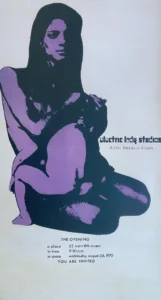
Everyone involved must have wondered if they would ever actually reach this point, but there it was: the invitation to the official Electric Lady Studios grand opening, held at “a place/in time/in space” on August 26, 1970. Jim Marron’s wife Paulette and their baby daughter were featured in the art. Jimi Hendrix left this party to fly to England for the Isle of Wight festival, never to return to Electric Lady Studios. (Modern Listener Archives)
The closing “Angel” certainly sounds like a work in progress, and that could be said for most of the contents of Electric Lady Studios: A Jimi Hendrix Vision – because that is exactly what they are. Anyone expecting to be blown away by stunning revelation after stunning revelation is likely to be disappointed by this long-awaited compilation of Jimi Hendrix at work in his new studio. Instead, the devil is in the occasionally minute details.
Would this music have been a better candidate for the official bootleg label Dagger Records? One wonders how well this expansive – and expensive – box set will sell for Sony, and how much appeal it will have for those who are not major league Jimi Hendrix fans. Regardless, even though the formats and structures of most of the material on Electric Lady Studios: A Jimi Hendrix Vision will be familiar, here it is the nuances – the performances within those structures – that are what make this box set continually interesting, and occasionally revealing.
